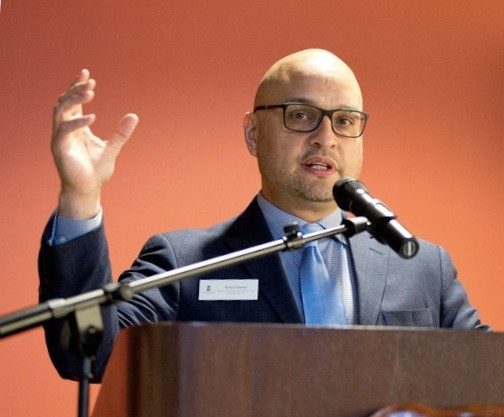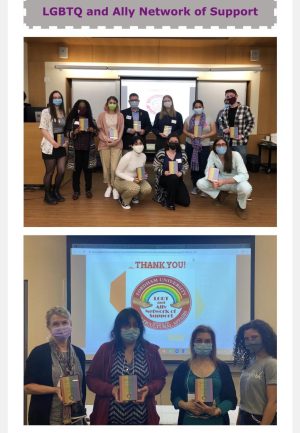Students of Color Express Dissatisfaction With University’s Diversity Efforts
Despite welcoming the most diverse incoming class yet, students of color feel there is additional work to be done to create a more inclusive community

COURTESY OF RAFAEL ZAPATA
The university’s quarterly diversity report was released on Oct. 5, showing a more diverse freshman class and new plans to combat racism.
November 8, 2021
Members of the Fordham community received the university’s quarterly diversity, equity and inclusion report on Oct. 5. The report consisted of messages from the Offices of the Chief Diversity Officer (CDO), Undergraduate Admission, Student Affairs, Alumni Relations and Fordham School of Law — as well as an update on the university’s action plan, titled “Addressing Racism, Educating for Justice.”
The report outlined the steps the CDO will take in order to foster a more inclusive and diverse environment. The CDO awarded a total of 22 mini grants to more than 20 departments with the goal of “exploring ways to integrate questions of race into their introductory and major/minor courses as part of the Teaching Race Across the Curriculum grant program,” the email stated.
The CDO will also pilot a series of mission-based community building and racial justice workshops. These programs are derived from work that Rafael Zapata, chief diversity officer, has conducted in a series of workshops for the Ignatian Colleagues Program.
The university also noted that it welcomed its most diverse first-year class yet.
There was a documented increase in the diversity of the Office of Residential Life student staff. Out of the 42 resident assistants (RAs) and resident first-year mentors, 71% Black, Indigenous, or people of color (BIPOC).
The university also noted that it welcomed its most diverse first-year class yet, with more than 44% of domestic students being students of color.
“In my conversations with students, folks are beginning to feel the impact of our more diverse incoming class as well as various faculty and staff who have been hired, diversifying the campus community by not only race, but gender and sexual orientation as well,” Juan Carlos Matos, assistant vice president for student affairs for diversity and inclusion, said.
“Fordham’s discourse on diversity seems to be catered to prospective students and prospective families, a rosy picture has been painted that does not necessarily reflect reality.”Hiba Imad, Fordham College at Lincoln Center ’24
However, many students believe there is more work to be done to make Fordham a diverse community.
Hiba Imad, Fordham College at Lincoln Center (FCLC) ’24, described the diversity on campus as “lackluster at best.”
“On paper, Fordham’s efforts seem decent, but that doesn’t translate as well into the daily lives of students,” Imad said. “Fordham’s discourse on diversity seems to be catered to prospective students and prospective families, a rosy picture has been painted that does not necessarily reflect reality.”
Keli Charles, FCLC ’25, said the lack of sufficient representation is not restricted to just the student body, as most of the faculty and staff identifying as people of color she has encountered “work in the kitchens or are janitors.”
“I haven’t seen many professors here that are people of color,” Charles said.
Imad has had a similar experience to Charles, noticing a lack of representation in the classroom setting.
“OMA does a lot of great work, but it feels like their reach is limited.”Hiba Imad
“Free thought and expression are restricted by the professor’s discomfort and reluctance to allow students to dissect topics and issues that affect them,” Imad said. “Representation would go a long way in increasing the quality of the courses offered at Fordham.”
With the core courses leaning heavily toward a Eurocentric curriculum, Imad said classes are especially restrictive for students like herself, who “would prefer to study topics relating to my heritage.” She said the emphasis on European perspective is not the best way to uphold the principle of cura personalis, as it “restricts the holistic education of the individual.”
Imad said she found herself enrolling in courses she feels no personal connection to.
The Office of Multicultural Affairs offers a variety of programs throughout the year that aim to educate the Fordham community and celebrate different cultures.
“While studying white philosophers has been beneficial in understanding the philosophical frameworks still popularly used today, I would love to learn about East Asian philosophy or Golden Age philosophers,” Imad said. “That would offer so much nuance and substance to a core class.”
The Office of Multicultural Affairs (OMA) offers a variety of programs throughout the year that aim to educate the Fordham community and celebrate different cultures.
“OMA does a lot of great work, but it feels like their reach is limited,” Imad said.
Charles noted that giving more funding to cultural clubs would be a step in the right direction because it would increase representation and improve holistic education.
“Make a point to have a diverse staff (janitors, professors, deans and all). Include people of color in important conversations, or in school decisions,” Charles said.














